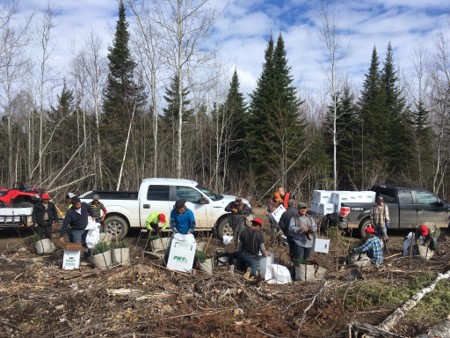H-2B guest workers in forestry: by the numbers
March 9, 2020
H-2B hiring forestry guest workers forest industry
Guest workers regenerating a northern Minnesota forest. (photo: @Chris_KTDunham, Twitter)
Guest workers hired through the H-2B visa program get jobs done. This is especially true across many forestry companies. Guest workers plant trees, conduct silvicultural treatments, and assist in tree nursery production.
A strong guest worker program can lead to a future forest products industry that is healthy and sustainable in the long term.
Last week, the Trump administration announced 35,000 additional seasonal H-2B guest worker visas available in 2020. The H-2B program provides opportunities to hire temporary foreign workers to fill low-skill and non-agricultural positions.
This post describes the status and trends of H-2B guest workers in forestry-related occupations using the most recent available data from the US Department of Labor.
H-2B guest worker database
All data are derived from the H-2B Disclosure Data available on the Department of Labor, Office of Foreign Labor Certification’s website. Data from FY2018 data are reported in this post, with historical data gathered from 2011.
Identifying forestry-related occupations can be done through querying each application’s Standard Occupational Classification (SOC) code. The SOC code is used by federal agencies to classify workers into occupational categories.
A number of variables are available that can provide insight into the characteristics of forestry-related positions in the H-2B program:
- Job title,
- Employer name and contact information,
- Number of requested and certified H-2B workers,
- Full or part time,
- Number of hours per week,
- Nature of temporary work need (e.g., seasonal or peakload)
H-2B guest workers in forestry occupations
In FY2018, 15,095 certified guest workers were employed in forestry-related occupations. These include the following occupations (number of positions in parentheses):
- Forestry and conservation workers (11,093 guest workers),
- Farm workers and laborers, crop, nursery, and greenhouse workers (1,682 guest workers),
- Recreation workers (1,401 guest workers), and
- Tree trimmers and pruners (919 guest workers)
Landscaping and groundskeeping workers accounted for the majority of certified H-2B workers, 50% of them in FY2018. Forestry and conservation workers were the second-most popular occupation. The three other forestry-related workers were included in the top 23 of all occupations (as identified by SOC code).

Forestry Worker and General Forestry Laborer were the most common job titles for forestry guest workers. As seen in the job titles, there is a lot of similarity among job titles in forestry-related occupations.
| Job title | Number of workers |
|---|---|
| Forestry Worker | 6056 |
| General Forestry Laborer | 979 |
| FOREST AND CONSERVATION WORKER | 753 |
| Nursery worker | 676 |
| Tree Trimmer / Climber | 664 |
| Nursery Worker | 607 |
| Forest & Conservation Workers | 527 |
| Tree Planter | 487 |
Regional trends in H-2B guest workers in forestry
Depending on forestry occupation, some regional trends existed for guest workers in FY2018. These trends were dependent on the employer’s home state:
- Forestry and conservation workers were most numerous in Mississippi and Oregon,
- Farm workers and laborers, crop, nursery, and greenhouse workers were concentrated in Arizona and the northeastern states,
- Recreation workers were most numerous in California, and
- Tree trimmers and pruners were concentrated in Texas and the southeastern US.

Hiring demographics of H-2B forestry guest workers
Seasonal work is common throughout forestry–think planting trees in spring. In H-2B applications, employers need to provide evidence that the work is tied to a season within a year (or some other event or pattern). The seasonal work must also be recurring in nature.
Peakload work is another type of work that may be specified in H-2B applications. While the employer may regularly employ permanent workers, peakload work indicates that the employer needs to supplement its permanent staff on a temporary basis due to a seasonal or short term demand.
Nearly 85% of all forest and conservation guest workers are seasonal. These percentages are similar for recreation workers and tree trimmers/pruners. For farm workers and laborer guest workers, the number of seasonal and peakload guest workers are approximately even.

All H-2B forestry guest workers were designated full time positions. Full time was indicated most commonly as 40- or 35-hour work weeks.

Trends in forestry H-2B guest workers
The total number of H-2B guest workers in forestry occupations has gone up by 77% since 2011. This increased from 8,527 certified guest workers in FY2011 to 15,095 certified guest workers in FY2018. Most of this increase has occurred since 2016.

The number of forest and conservation workers has increased by 34% since 2011. However, the largest increases in forestry-related occupations has been in three of the smallest occupations. Certified guest workers in recreation have increased by more than 2,000% since 2011, followed by farm workers and laborers and tree trimmers/pruners.

| Job title | Workers in 2011 | Workers in 2018 | Percent increase |
|---|---|---|---|
| Recreation workers | 66 | 1401 | 2023 |
| Farm workers and laborers, crop, nursery, and greenhouse workers | 96 | 1682 | 1652 |
| Tree trimmers and pruners | 106 | 919 | 767 |
| Forest and conservation workers | 8259 | 11093 | 34 |
Conclusion
Guest workers under the H-2B program are essential for many organizations in the forest products industry. The total number of H-2B guest workers in forestry-related occupations has increased by 77% since 2011.
Demand for guest workers varies regionally across the US depending on the nature of the forestry job. In forestry occupations, most H-2B guest workers are hired seasonally and on a full time basis. Maintaining a strong commitment to the H-2B program, as evidenced from last week’s news, can promote a healthy and viable forest products industry in the future.
By Matt Russell. Leave a comment below or email Matt with any questions or comments.